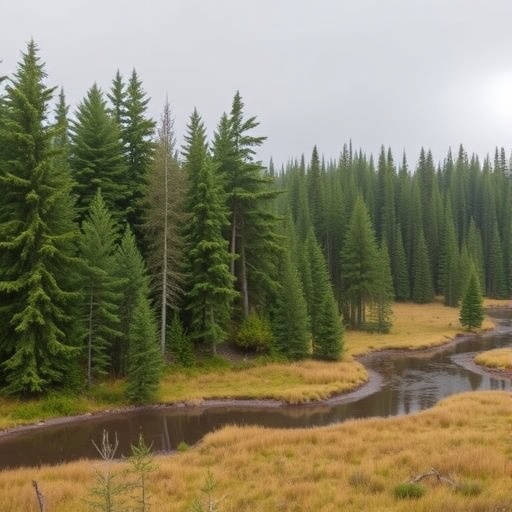The boreal forests, often termed as the world’s lungs, encompass vast stretches of land predominantly found in Canada, Russia, and Scandinavia. These forests play a pivotal role in global carbon cycling, acting as significant carbon sinks due to their dense tree cover and extensive biomass. A recent study published in Communications Earth & Environment by Dsouza et al. reveals groundbreaking findings on the potential of Taiga reforestation and afforestation efforts, particularly at Canada’s boreal edge. The implications of this research could reshape our understanding of natural climate solutions.
The research illustrates how strategic reforestation and afforestation efforts in the Taiga region can result in significant carbon capture, countering the increasing levels of atmospheric carbon dioxide. This study meticulously evaluated the carbon removal capabilities of these forest systems, employing rigorous methodologies and advanced modeling to project the long-term impacts of such ecological interventions. As global temperatures rise and extreme weather events proliferate, understanding the carbon dynamics in these boreal ecosystems is of paramount importance.
Notably, Taiga reforestation initiatives focus on restoring degraded landscapes and enhancing biodiversity. This is not merely about planting trees; it involves reviving entire ecosystems that have been disrupted by human activity. The study emphasizes that every tree planted contributes not only to carbon capture but also to the restoration of habitat for countless species, underscoring the interconnectedness of environmental restoration and climate change mitigation efforts.
The research team also assessed various afforestation scenarios, exploring how different tree species can influence carbon sequestration rates. By incorporating native species, the researchers found that the resilience of these forests against pests, diseases, and climate variability was significantly enhanced. Such adaptability is crucial as the world faces shifting climate patterns that threaten established ecosystems.
Furthermore, the study delves into the economic ramifications of Taiga reforestation and afforestation. As nations seek sustainable solutions to combat climate change, investing in forest restoration presents an economically viable path. The findings suggest that these ecological investments could yield substantial financial returns through ecosystem services, including carbon credits, timber production, and improved water quality.
The research also underscores the importance of policy and governance in advancing reforestation projects. Collaborative efforts between governments, indigenous communities, and environmental organizations are essential to ensure that afforestation initiatives are effectively implemented and equitably benefit marginalized communities. Policies that incentivize reforestation not only foster environmental sustainability but also drive economic growth.
These findings are timely, considering global commitments such as the Paris Agreement and recent initiatives advocating for nature-based solutions in the face of climate change. By quantifying the carbon removal capacity of Taiga forests, this research aligns with global efforts aimed at reducing carbon footprints and enhancing carbon sinks.
In addition to carbon capture, the study highlights other ecological benefits associated with biodiversity in boreal forests. Rich habitats support a plethora of species, which in turn contribute to the ecosystem services that are vital for human survival. This biodiversity acts as a buffer against climate variability, ensuring that ecosystems remain robust in the face of environmental challenges.
As climate scientists warn of the dire consequences of unchecked carbon emissions, the role of forest ecosystems as carbon storages will become increasingly critical. The research by Dsouza et al. points towards a promising avenue for climate mitigation through enhanced carbon management practices within Canada’s boreal zone.
The strategy proposed does not merely aim to sequester carbon; it advocates for an integrated approach that encompasses conservation, restoration, and sustainable development. By employing a multifaceted strategy, the researchers argue that it is possible to tackle climate change, support biodiversity, and promote local economies, all at the same time.
Moreover, this study acts as a clarion call for collective action, emphasizing that individual contributions to reforestation should not be underestimated. Community-led initiatives and grassroots movements can be immensely powerful, each contributing towards the wider goal of combating climate change. The collaborative spirit of reforestation can galvanize public support and mobilize resources from various sectors.
As we look towards future climate strategies, the research highlights the urgency of implementing reforestation efforts across multiple landscapes. As land use dynamics shift in response to climate stressors, proactive measures such as those proposed by Dsouza et al. can pave new pathways for environmental accountability and resilience.
Overall, the study’s comprehensive approach and its insights into the substantial carbon removal capacities of boreal ecosystems place it at the forefront of climate research. It showcases that the potential to combat climate change lies at the junction of nature, science, and human ambition, positioning reforestation as not just an option, but an imperative.
In conclusion, the findings from Dsouza et al. are a resounding acknowledgment of the natural world’s ability to aid in climate mitigation when given the chance and support. As nations grapple with the growing urgency to address climate change, the boreal forests stand out as a beacon of hope, reminding us of the critical role that ecosystems can play in creating a sustainable future for our planet.
Subject of Research: The carbon removal capacity of Taiga reforestation and afforestation at Canada’s boreal edge.
Article Title: Substantial carbon removal capacity of Taiga reforestation and afforestation at Canada’s boreal edge.
Article References:
Dsouza, K.B., Ofosu, E., Boudreault, R. et al. Substantial carbon removal capacity of Taiga reforestation and afforestation at Canada’s boreal edge.
Commun Earth Environ 6, 893 (2025). https://doi.org/10.1038/s43247-025-02822-z
Image Credits: AI Generated
DOI: https://doi.org/10.1038/s43247-025-02822-z
Keywords: Boreal forests, Taiga, carbon sequestration, reforestation, afforestation, biodiversity, climate change mitigation, ecosystem services, sustainable development.




